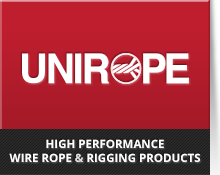Fiber Properties
Nylon | Polyester | K-SPEC® | Aramid | Comparison Table
Nylon
Nylon is the most popular fiber used in flat web slings. Tests indicate that the nylon fiber seems to be much more ‘forgiving’ if subjected to bunching and placement over irregular hardware shapes than Polyester. At working load Nylon stretches about 6- 10% which is roughly double that of the competing polyester fiber. Nylon fibers are unaffected by common grease and oil and have good resistance to aldehydes, hydrocarbons, ethers and some alkalis, while degradation ranging from none to moderate occurs with exposure to certain alkalis. Nylon slings are not suitable for use with acids and bleaching agents (as found in boat hull cleaners). Exposure can result in degradation from none to total. Dilute acids such as hydrochloric and sulfuric in 10% concentrations at room temperature cause a significant loss in strength in 10 hours. Nylon products lose 15% of their Rated Capacity (WLL) when wet. It is not recommended to wash Nylon slings in commercial- or household washing machines as this process damages surface yarns resulting in unpredictable loss of strength.
Nylon fibers are affected by UV rays and sunlight resulting in considerable strength loss over time. We recommend to have all nylon slings which are exposed to UV-rays proof loaded and inspected once a year.
Nylon is NOT significantly affected by compounds of the following classes: alcohol, dry cleaning solvents, halogenated hydrocarbons, ketones, soaps and synthetic detergens or water.
- Concentrated formic acid
- Phenolic compounds at room temperature
- Calcium chloride in methanol at room temperature
- Hot solutions of zinc chloride in methanol
- Benzyl alcohol at the boil
- Glacial acetic acid
- Ethylene Chlorohydrin
- Ethylene Glycol
Polyester
Polyester is not significantly affected by most compounds of the following classes: alcohols, dry cleaning solvents, halogenated hydrocarbons, ketones, soaps and synthetic detergent or water. Polyester also has good to excellent resistance to aqueous solutions of most weak acids at the boil, and to most acids to room temperature, but is disintegrated by concentrated sulfuric acid (95%) at room temperature. Polyester products also have good resistance to most aqueous solutions or strong alkalies at room temperature, but are degraded by the same solution at the boil. Oxidizing agents and bleaching treatments ordinarily used by the textile industry also do not degrade polyester fiber.
However, some preliminary tests have shown that Polyester slings are much more affected than Nylon slings when subjected to bunching and small curvatures found in some rigging attachments. Stretch at Rated Capacity (WLL) is approximately 3-4%. Polyester does not lose strength as a result of moisture absorption.
 Twin-Path® slings used in installing a 125 ton refinery reactor |
K-SPEC®K-Spec® fibers are a specialty high performance combination of High Density yarns. Chemical and performance characteristics are those of the primary fibers. Stretch at working load limit is approximately 1% and the acceptable temperature exposure range is the same as conventional fibers. K-Spec® resists many chemical agents and retained 100% of the original strength when immersed for 6 month in the following: Clorox® degraded High Density Polyethylene fibers by approximately 10% after the same 6 month immersion test. |
 Twin-Path® Slings were used in the construction of the addition to the New-York Hospital, New York City. The slings lifted concrete floor sections weighting around 500 tons each. The planning and construction of this very unique lifting set-up was done by Canron Construction, Rexdale, Ontario. The floor sections were constructed off site in New Jersey and transported by barge up the East River. Once alongside the construction site which was located at the river’s shoreline, the Franklin D. Roosevelt Driveway was closed during the late night hours to give Canron a 4 hour ‘window’ to position the floor sections. The slings were manufactured by us in Mississauga. |
AramidAramids are resistant to most ketones, alcohols, dry cleaning solvents and many other organic solvents. Its acid resistance is superior to that of nylon but is not as good as that of polyester. Aramids show good resistance to alkalis at room temperature, but is degraded by strong alkalis at higher temperatures. Aramids are compatible with fluorine-containing elastomers, resins, and refrigerants at high temperatures, and is resistant to fluoride compounds in concentrations usually encountered in stack gases from metallurgical and rock-processing operations. The resistance of aramids to oxides of sulphur at temperatures above the acid dew point is superior to that of polyester. Below the dew point, concentrated sulfuric acid may condense on the fiber and cause a progressive loss in strength. In moderate to strong acid or alkali environments, evaluation of aramids should be made to ensure that the sling will perform acceptable before use. Stretch of Aramid load bearing sling yarn is below 1% at Rated Capacity (WLL). |
| Comparison Table | ||||
|---|---|---|---|---|
| Nylon | Polyester | K-SPEC™ | Aramid | |
| Strength (gr.p.denier) | 8.0 to 9.0 gpd | 6.5 to 9.0 gpd | 27 gpd | 23 gpd |
| Specific Gravity | 1.14 | 1.38 | 1.10 | 1.44 |
| Ability to Float | Sinks | Sinks | Sinks (slow) | Sinks |
| Stretch @ Break | 16 to 20% | 10 to 12% | 3.6% | 3.6% |
| Stretch @ WLL | 6 to 10% | 3 to 4% | < 1% | < 1% |
| Moisture Absorbency | 9% of weight | 1% of weight | 2% of weight | 5% of weight |
| Working Temperature | 90°C – 194°F | 90°C – 194°F | 82°C – 180°F | 150°C – 300°F |
| Identification | Melts before burning. Forms bead. Celery odor. |
Melts before burning. Forms bead. Pungent odor. |
White colour with red ID marker |
Melts before burning. Forms bead. Celery odor. |
| Abrasion Resistance | Good | Good | Excellent | Kevlar: Fair Slingmax Aramid: Excellent |



